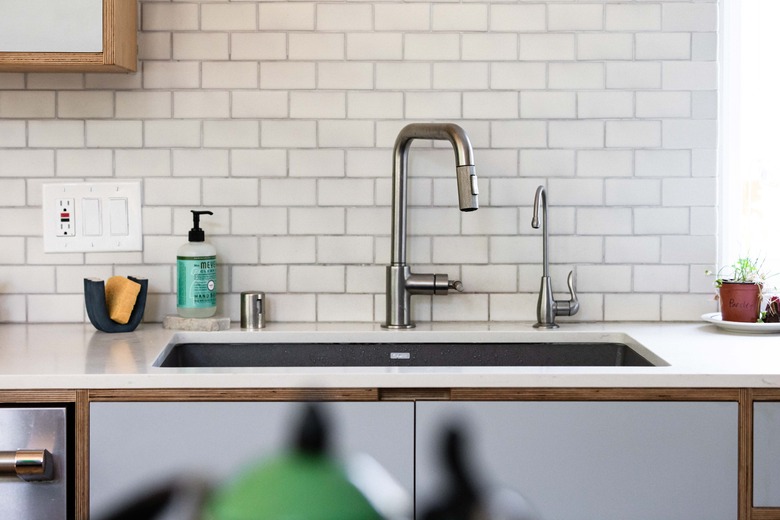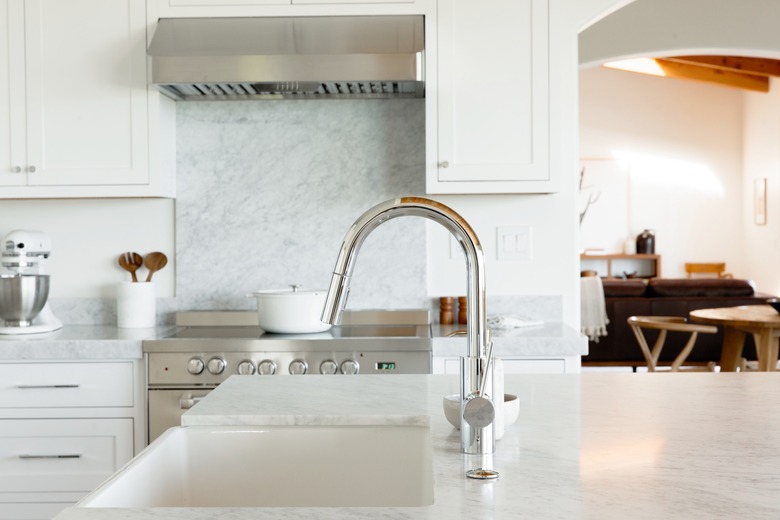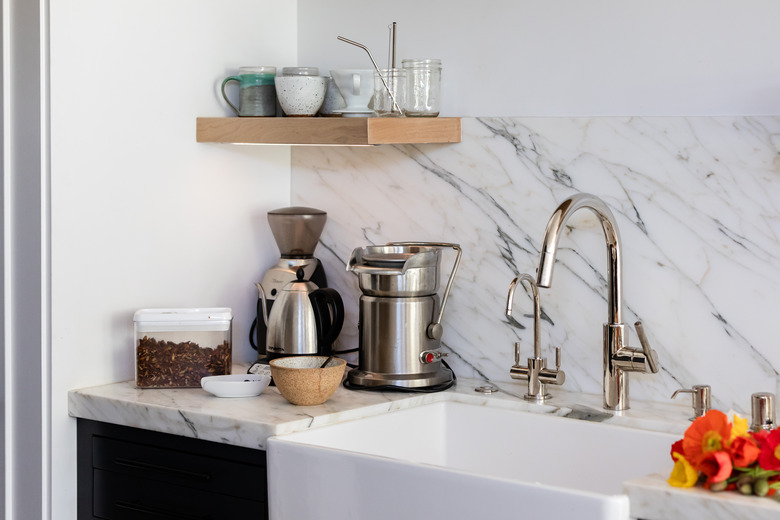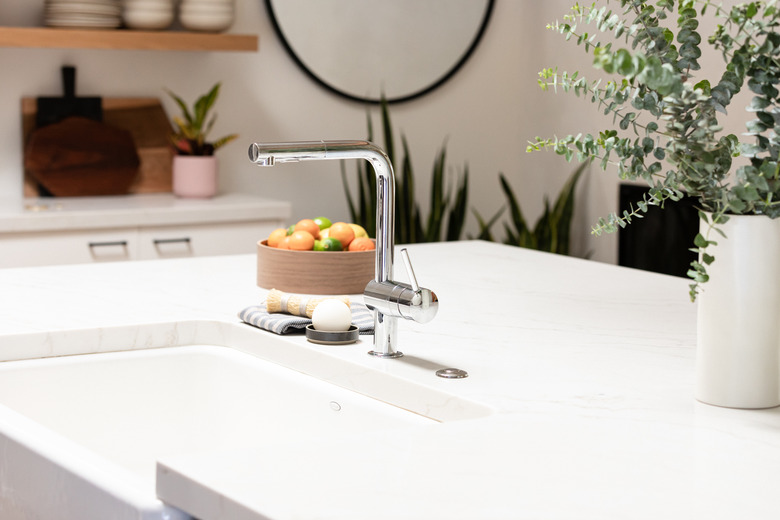Kitchen Faucets: What You Should Know
We may receive a commission on purchases made from links.
The purpose of a kitchen faucet is simple: It controls water flow and shuts off the water when you're not using it. Faucet designs have evolved to include ever more sophisticated ways to do this, and today, you can choose a faucet type that seamlessly controls temperature and even operates without ever having to touch the handle. You can also choose a faucet with a built-in sprayer or one that swivels out to reach pots on the countertop or stove.
The kitchen faucet is the centerpiece of the kitchen, and every home needs one, so faucet design has evolved to fit with interior décor trends. Inside every faucet, no matter how ornate or streamlined it looks, is standardized basic piping and one of only four valve mechanisms. The standardization is a guarantee that every faucet will work in your home without any modifications to your plumbing system — with some limitations.
Kitchen Faucet Valve Design Through the Years
Kitchen Faucet Valve Design Through the Years
The Greeks, Romans, medieval Europeans and those in Renaissance times as well as people in pre-19th-century China, Japan and other places may have loved to cook, but they had to rely on pumps because the first screw-type faucet, known as a compression faucet, wasn't invented until 1845. It was the classic two-handle faucet, and it was the only type available until Al Moen, after getting scalded under a hot-water faucet, invented the single-handle mixing faucet in 1937. Moen's faucet made use of a cartridge, and to this day, the Moen Company, which he founded, specializes in this type of faucet.
The Delta faucet, introduced in 1954, made use of a ball valve developed by Landis H. Perry and Alex Manoogian, and it became an instant hit because it made the water temperature easier to control. Today, Delta is known primarily for this single-handle faucet type. Finally, in the 1970s, Wolvering Brass introduced the even more reliable and controllable ceramic-disk faucet. Cartridges and ceramic disks have since been incorporated into two-handle faucets, but ball-valve faucets all have only one handle.
One more type of valve has come on the playing field in conjunction with touchless kitchen faucet technology. A touchless faucet has a motion sensor that sends a signal to an electromagnetic solenoid valve, which is made of a material resembling rubber. When the sensor sends a signal, an electric charge from a battery or transformer opens the valve, and when the signal stops, a spring closes it.
Which Kitchen Sink Faucet Is Best?
Which Kitchen Sink Faucet Is Best?
Valve type isn't a primary consideration when choosing a kitchen faucet — with one exception. Two-handle faucets with compression valves have largely outlived their usefulness, partly because they tend to get squeaky with age and partly because they can't have an easy-to-operate lever handle because the lever bumps against the wall. Compression faucets are impractical given the easy access to a double- or single-handle kitchen faucet that is just as reliable and doesn't require much effort to operate.
Given the simple job of faucets as water dispensers, the best one is probably the one that meets most of your preferences. You'll want to consider:
- Style and finish
- Type of spout
- Accessories, such as a sprayer
- Ease of use
- Cost
You can't choose just any faucet, though, because your kitchen sink or countertop has to have the right number of predrilled holes to accommodate it. Only a single-handle faucet will fit in a one-hole sink. If you want a two-handle kitchen faucet, your sink needs at least three holes, and it may need more if you want a side spray or soap dispenser.
Faucet Styles and Finishes
Faucet Styles and Finishes
Faucet styles range from minimalist, with sleek pieces of brushed or shiny metal extending from the sink deck or countertop, to complex, such as an ornate bridge faucet with all its interconnected piping visible above the sink. The model name usually says it all, with words like "Tuscan" denoting a utilitarian farmhouse appearance, "Mediterranean" referring to posh elegance and "Swedish" signifying silken sophistication.
All but the least-expensive faucets have metal casings, although under the hood, they all have the same copper or brass pipes to carry the water. Available finishes include polished or brushed nickel or brass, chrome, copper, white porcelain and matte black, which looks great with a stainless steel sink. All these finishes tarnish to varying degrees, but that's nothing you can't fix with a little vinegar (for removing hard-water stains) and metal polish.
Spout and Spray Options
Spout and Spray Options
For a faucet to be useful in the kitchen, it must reach the middle of the sink, and since many kitchens have double sinks, most faucets have swivel spouts. The spout is usually 8 inches long, and it's typically mounted 3 inches above the countertop. That doesn't give much room for washing pots, so instead of a straight spout, you can choose a faucet with a low arc, which provides an extra 2 inches of clearance, or a high arc, which provide 8 to 10 more inches.
A sprayer is a virtual necessity in a busy kitchen, and instead of relying on a side spray attachment, you have two other options. A pull-down kitchen faucet has a sprayer built into a spout that arcs to the sink, allowing you to get down and dirty with the dishes or to prerinse them for the dishwasher, while a pull-out kitchen faucet has a sprayer that is mounted on a straight arm that angles toward the user. The pull-out spray option gives you the ability to use the sprayer to fill pots on the countertop and keep the countertop clean.
Wall-Mount and Pot-Filler Faucets
Wall-Mount and Pot-Filler Faucets
A wall-mount faucet is a two-handle faucet that mounts to the wall instead of the sink deck, and because you can mount it at any height, you can maximize the space underneath it to allow you to stack more dishes or clean extra-large pots. People choose a wall-mount more for what it does than how it looks, so the style is utilitarian, and the finish is polished chrome or some other easy-to-clean material.
A pot filler mounts on the wall and provides even more functionality because it has a swivel spout that can extend twice the distance of a standard one, allowing you to fill pots that are on the countertop or stove. A pot filler can have one or two handles, but there is usually an extra handle next to the spout so you can turn the water on and off without having to reach over the sink. Because it extends beyond the sink, a pot filler can get water where it isn't supposed to go, such as the floor or stove, which is one of its drawbacks.
Because the water pipes for a wall mount go behind the wall and stub out above the sink, you can't replace a deck mount with a wall mount because the pipes for a deck mount stub out under the sink cabinet. The retrofit requires some extra rough-in plumbing, which is best handled by a pro.
What's Involved With Replacing a Kitchen Faucet?
What's Involved With Replacing a Kitchen Faucet?
Before you purchase a new faucet, it's important to determine whether your sink or countertop has the proper number of holes to accommodate it. If you want to install a single-handle kitchen faucet that requires one hole in a sink that has a double-handle faucet, choose a model with a deck plate that covers the extra holes. Conversely, you can't replace a single-hole faucet with one that requires three holes unless you're willing to replace the sink.
The most difficult part of the replacement procedure is usually removing the old faucet — there isn't much room to work, and the nuts holding the faucet are often frozen by corrosion. If you do this job yourself, you'll want to get a basin wrench, which has a long handle that reaches behind the sink to clamp onto the nuts, allowing you to more easily apply the torque to turn them.
After you've removed the old faucet, just follow the installation instructions that come with the new one. They will tell you how to fasten the faucet to the sink deck and countertop and how to hook up the water-supply tubes. Some faucets, such as pull-out spray ones, have hoses that must be connected under the cabinet, and if they don't have quick-connect fittings, you'll have to tighten these connections with a wrench.
ADA Compliance for Kitchen Faucets
ADA Compliance for Kitchen Faucets
If you're choosing a faucet for a household with one or more disabled individuals, you'll want to pay attention to rules established by the Americans with Disabilities Act (ADA). If a faucet is ADA compliant, you'll see that on the label, and it probably means the faucet has a single handle since those are easiest for disabled people to use. The ADA guidelines specify that the faucet handle should require no more than five pounds of force to operate.
A touchless faucet requires no force to operate, so it's an excellent choice, but to be ADA compliant, it must not shut off for at least 10 seconds after the sensor has been activated. Remember to choose a battery-operated model if you don't have an easily accessible outlet under the sink to plug in a transformer.
Basic Faucet Maintenance
Basic Faucet Maintenance
With time, every kitchen faucet collects gunk and needs a good cleaning. To protect the finish, it's best to stay away from abrasive cleaning tools and supplies. Start by washing with dish detergent and water and then wipe off water stains with a rag soaked with a 50/50 solution of vinegar and water. For really tough stains, sprinkle baking soda on the faucet body and scrub with a wet toothbrush.
If water flow becomes less than normal, the aerator is probably clogged, and you can unclog it by removing it and soaking it overnight in vinegar. Some aerators are recessed, and you may need an inexpensive tool called an aerator key to remove yours. The aerator in a pull-down faucet or a pull-out spray one is usually located behind the spray head, which is easy to remove. You just unscrew it.
When a kitchen faucet leaks from the spout or you can't control the temperature, you usually have to replace the cartridge, disk or ball valve. This requires shutting off the water and disassembling the faucet. This is usually a straightforward procedure that doesn't take much time, but you'll want to consult your owner's manual or the manufacturer's website for model-specific instructions and a list of required replacement parts.



